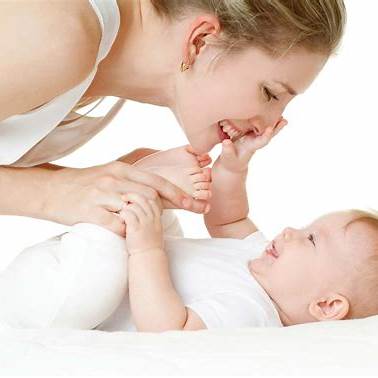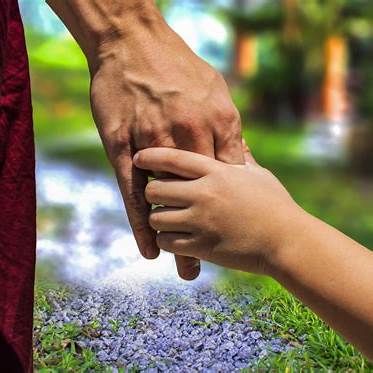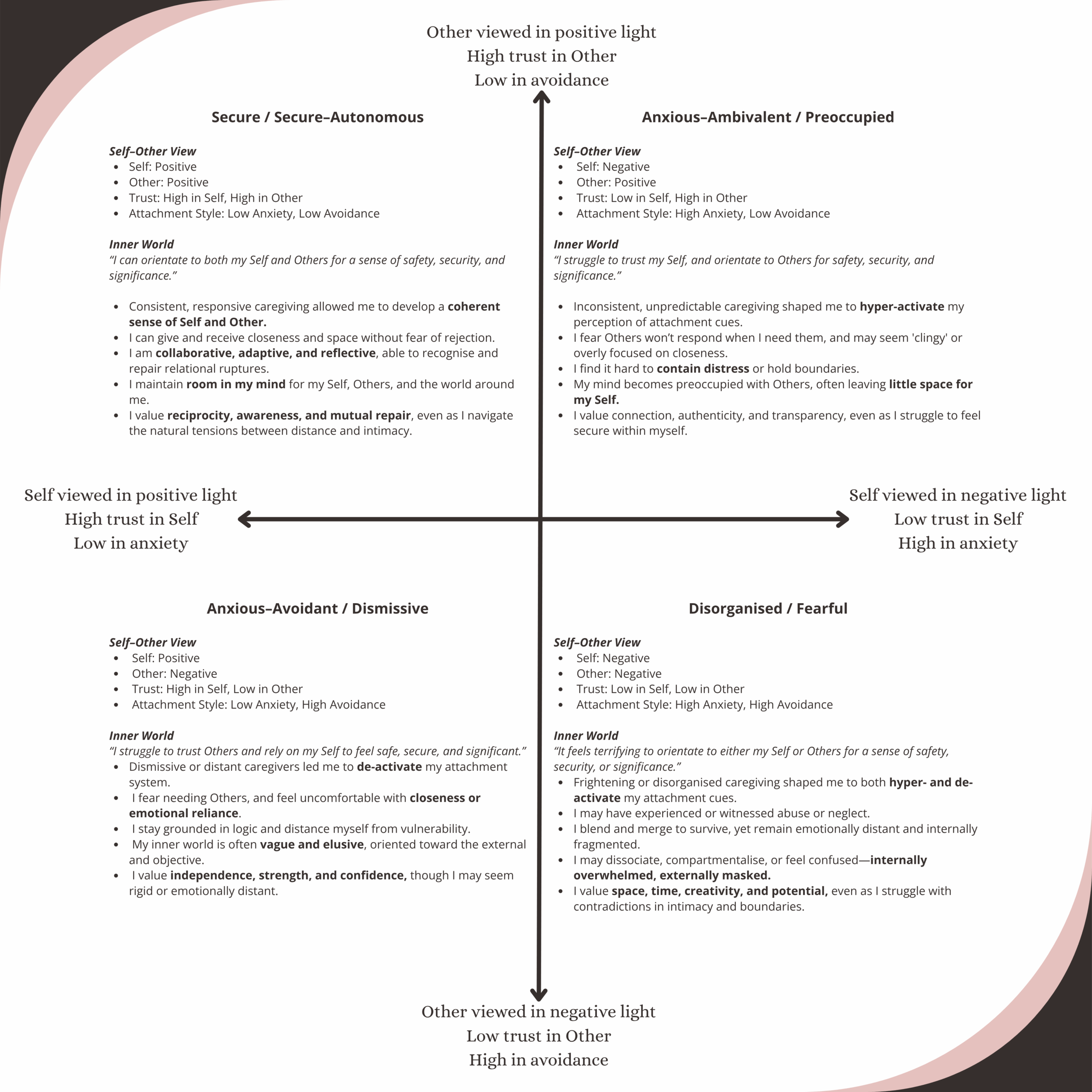Contents of Article
- 1 The Rhythm of Attachment: How we come to be with Self, Other, and World.
- 1.1 How Attachment Tendencies Form
- 1.2 Attachment as Contextual and Evolving
- 1.3 The Living Pulse of Who We Are
- 2 Childhood & Adult Attachment Tendencies:
- 2.1 Childhood Attachment Tendency: Secure Adult Attachment Tendency: Secure–Autonomous
- 2.2 Childhood Attachment Tendency: Anxious–Ambivalent Adult Attachment Tendency: Preoccupied
- 2.3 Childhood Attachment Tendency: Anxious–Avoidant Adult Attachment Tendency: Dismissive
- 2.4 Childhood Attachment Tendency: Disorganised Adult Attachment Tendency: Fearful
- 3 Returning to the Rhythm
Attachment is not only about relational patterns; it’s the interactive regulation of emotion and arousal between two minds and two bodies.
Allan Schore
The Rhythm of Attachment:
How we come to be with Self, Other, and World.
Attachment. It is the core of survival. The very mammalian dynamism that prompts and organises our earliest search for connection and protection.
At its most primitive – fundamentally and physiologically – attachment is our instinctual emotional-motivational drive to survive and thrive.
Primarily as a biological imperative, attachment increases our survival via the pursuit and preservation of proximity. Yet, it is far more than a predisposition of preservation. Attachment is a resonant relational rhythm imbued with a spaciotemporal synchronicity that cultivates a coherent and connected sense of Self.
Importantly, across the transitional arcs of maturation, attachment unfolds as a developmental dynamic – a progression of proximity: from the physical nearness that soothes the infant’s body, to the affective closeness that anchors the child’s heart and mind, and ultimately to an internalised, embodied sense of felt security within the adult Self.
Significantly, attachment is the primary relational process through which the embodied brain develops contextually and coherently. With consistent and contingent interaction, exchanges are internalised shaping and linking various aspects of our physiological, psychological, and relational domains of experience. Such is an attuned process where sensation, perception, and interpretations within and between are embodied and embedded.
This journey is not linear but rhythmic and resonant. An ebb and flow of ‘me’ and ‘not-me’, of inner and outer, of connection and of separation, and ultimately of Self, Other, and World differentiation and integration.
In times of both distress and delight, attachment is the embodied and relational manner in which humans orientate and connect. It is the felt experience of being known, seen, and safe – first in the arms of an Other, and later within the sanctuary of one’s own being. As such, attachment is not simply a developmental milestone; it is the living pulse of how we come to be with our Self, Others, and the World that surrounds us.
How Attachment Tendencies Form
From our first breath, we are wired to seek safety through connection. When caregiving is consistent, responsive, and attuned, it lays the foundation for secure attachment tendencies. In these conditions, the developing embodied and relational mind learns that closeness can coexist with safety, and that the experience of distress can be met with comfort and care.
 However, when caregiving is unpredictable, overwhelming, emotionally unavailable, or misattuned, the developing mind adapts. These adaptations are not flaws – they are forms of intelligent, embodied protection. The relational strategies we develop in early life that prioritise survival over connection. Over time, these strategies become patterns of relating – what we now refer to as attachment tendencies.
However, when caregiving is unpredictable, overwhelming, emotionally unavailable, or misattuned, the developing mind adapts. These adaptations are not flaws – they are forms of intelligent, embodied protection. The relational strategies we develop in early life that prioritise survival over connection. Over time, these strategies become patterns of relating – what we now refer to as attachment tendencies.
Attachment tendencies are not fixed traits or pathologies. They are the developing minds best attempt to maintain proximity, predictability, and protection in the face of relational ambiguity or threat. They shape how we signal our needs, how we respond to others’ emotional availability, and how we regulate our internal world in the presence or absence of connection.
Attachment as Contextual and Evolving
Importantly, we are not monolithic in how we attach. Attachment tendencies are not singular states that exist in isolation, but ever-emergent, dynamic, and context-dependent patterns that arise in response to perceived safety, familiarity, and relational demands. We may move toward connection with openness in one setting, and lean into avoidance or hyper-vigilance in another. These shifts are not inconsistencies—they are reflections of our adaptive intelligence.
We can carry multiple tendencies, often layered by developmental stage, relational role, or environmental context. For example, one might exhibit anxious tendencies in intimate relationships, avoidant tendencies at work, and more secure capacities with close friends. These variations are part of the fluidity of human attachment – not signs of flaw or fragmentation, but of complexity.
Over time, and through repeated experiences of co-regulated connection, our patterns can shift. With increasing self-awareness and relational safety, the parts of us shaped by insecurity can begin to soften. What once served as protection can begin to reorient toward connection. The inner scaffolding of attachment is not static; it is always in motion, always in the process of becoming.
The Living Pulse of Who We Are
Attachment, then, is not merely something that happened in childhood – it is an embodied relational knowing or a pattern of protection that continues to unfold within and between Self, Other, and World.
Indeed, attachment shapes how we come to expect the World to meet us, and how we meet our Self within it. It determines not only how we connect to Others, it is also how we protect our Self from disconnection, disappointment, or dismissal.
 To understand attachment is to understand the fundamental nature of our relational world: the implicit memories and maps that guide our felt sense of safety, our capacity for intimacy, and our core sense of Self. It is a dance between dependence and differentiation, between longing and fear, between reaching out and pulling away. Ultimately it is a dance of separation and connection – of aloneness and togetherness.
To understand attachment is to understand the fundamental nature of our relational world: the implicit memories and maps that guide our felt sense of safety, our capacity for intimacy, and our core sense of Self. It is a dance between dependence and differentiation, between longing and fear, between reaching out and pulling away. Ultimately it is a dance of separation and connection – of aloneness and togetherness.
In this light, attachment is not just a feature of development – it is the very fabric of human being. It is the ever-emerging expression of wovenness: how we become who we are, in the presence of another.
Alongside the knowledge that attachment is part of the living pulse within us, and to identify our attachment style, we can gently explore patterns and tendencies in how we relate to closeness, safety, and autonomy – especially in the context of intimate relationships, friendships, and caregiving. The following questions and the attachment descriptions presented below can offer insight into the relational knowings and patterns of protection our bodies may hold.
- How do I connect and communicate with my Self, with Others, and with the world around me?
- Do I feel safe relying on others — and letting them rely on me?
- Can I trust my Self? Can I trust Others?
- When I feel vulnerable or emotionally stirred, do I turn toward an Other, away from them, or against them?
- Are there parts of me that, when feeling overwhelmed or confused, seek proximity and comfort from an Other? Do I fear they will not be there the way I need them to be? Or is it that I fear they will engulf me — that turning to them might mean losing my Self?
- Do I feel like I must put the Other’s needs before my own in order to stay safe or loved? Do I find myself merging or sacrificing my Self to remain connected?
- Do I feel more secure when I am fiercely independent, holding space away from the Other rather than with them?
- In high stress, is my go-to response to flee and flock toward the Other, to fight against the Other, or to flee away from the Other altogether? Or is it that I freeze and shut down — sensing numbness, collapse, or disconnection from both Self and Other?
- Can I stay emotionally present when someone else is distressed? What happens in my body when I witness the vulnerability of another?
- Do I feel worthy of being loved, even when I am not performing or perfecting?
- Do I fear that if I am truly seen — with all my complexity — I will be rejected or abandoned?
- What did I learn about love, closeness, and safety in the relationships that shaped me?
Childhood Attachment Tendency: Secure
Adult Attachment Tendency: Secure–Autonomous
Self viewed in positive light, Other viewed in positive light; high trust in Self, high trust in Other; low in anxiety, low in avoidance.
I can trust my Self and Others, and I am able to orientate to both for a sense of safety, security, and significance. In childhood, my parents were predominantly consistent and predictable—I was neither overprotected nor indulged, and my needs were sufficiently met. Therefore, I implicitly internalised a coherent sense of Self and Other, with perceptions of availability, responsiveness, worth, and meaning.
As an adult, I may sometimes feel insecure, and I can recognise this in Others as well. However, I am able to connect to distress with intimacy, and am comfortable giving and receiving closeness and space without fearing rejection or abandonment.
I know I can trust Others, and I know I can also trust my Self. Therefore, I am collaborative and communicative, as well as compassionately adaptive. My subjective experience is open and flexible, and while maintaining a sense of contextual coherence, I have room in my mind for both my Self and Others, as well as the world around me.
While I do sometimes struggle with both distance and intimacy, I can both set and respect boundaries. I value reciprocity, Self-and-Other awareness, and the recognition and reparation of relational ruptures.
Childhood Attachment Tendency: Anxious–Ambivalent
Adult Attachment Tendency: Preoccupied
Self viewed in negative light, Other viewed in positive light; low trust in Self, high trust in Other; high in anxiety, low in avoidance.
I struggle to trust my Self, and I orientate to Others for a sense of safety, security, and significance. In childhood, my parents may have been self-absorbed and unpredictable—seeking proximity and support was an unreliable process. Sometimes there was responsive care, but not consistently so. Therefore, I implicitly began to hyper-activate my perception toward attachment cues for both threat and availability.
As an adult, I deeply fear that Others will not respond when I need them. I may struggle to contain distress or tolerate intimacy (closeness), and I implicitly hold vigilant focus on protecting my Self from pain. I find it difficult to differentiate from Others and may pursue closeness in ways that Others experience as ‘clingy.’
Though I cannot trust Others will always be there, I certainly cannot trust my Self. At times, I can seem consumed with panic and a preoccupation that I will be abandoned or rejected. My subjective experience is often so dominated by concern for the Other that there is little room in my mind for a coherent sense of my Self.
While I struggle with boundaries, I am highly expressive, engaging, and communicative. I value connection, authenticity, and transparency.
Childhood Attachment Tendency: Anxious–Avoidant
Adult Attachment Tendency: Dismissive
Self viewed in positive light, Other viewed in negative light; high trust in Self, low trust in Other; low in anxiety, high in avoidance.
I struggle to trust Others and tend to rely on my Self for a sense of safety, security, and significance. In childhood, my parents may have been disengaged, disapproving, or distant—seeking proximity and support was often dismissed or denigrated. Therefore, I implicitly began to de-activate my perception toward attachment cues for threat and availability.
As an adult, I deeply fear having to rely on Others, so much so that I struggle to connect with distress or tolerate intimacy (closeness). I implicitly distance from perceived threat or the need for Others. I struggle to affectively connect and tend to keep things grounded in logic and control.
I know I cannot trust Others, so I trust and rely only on my Self. At times, this can make me seem rejecting or rigid. My subjective experience is often vague and elusive—my mind oriented to the objective—leaving little room for a coherent sense of my inner Self.
While I struggle with intimacy and often focus on achievement, fun, and external success, I value independence, strength, and confidence.
Childhood Attachment Tendency: Disorganised
Adult Attachment Tendency: Fearful
Self viewed in negative light, Other viewed in negative light; low trust in Self, low trust in Other; high in anxiety, high in avoidance.
I struggle to trust my Self or Others. In fact, it can feel terrifying to orientate to either for a sense of safety, security, or significance. In childhood, my parents may have been both frightening and frightened—confused and confusing. I may have been neglected, abused, or exposed to threatening environments. Seeking proximity and support was, at times, a life-threat. Therefore, I implicitly began to both hyper-activate and de-activate my perception toward attachment cues for threat and availability. I became a chameleon—blending, merging, sometimes fusing—while paradoxically remaining intimately distant.
As an adult, I am deeply fearful, emotionally labile, and often feel diffuse, compartmentalised, or fragmented. I may struggle to contain distress internally, though externally it may not be apparent—at times, I dissociate without Others being aware. I implicitly hold vigilant focus on protecting my Self from Others and sometimes struggle to differentiate past from present, or real from unreal.
I know I cannot trust Others, and I know I cannot trust my Self. At times, I may seem confused or confusing. My subjective experience can be overwhelming—leaving little space in my mind for a coherent sense of Self or Other.
While I struggle with boundaries and intimacy—and often appear contradictory—I value space, time, creativity, and potential.
Returning to the Rhythm
 Remember, to understand our attachment tendencies is not to reduce our Self or Others to categories, but to recognise the parts of us that learned how to navigate and fulfil our innate core needs. Indeed, these tendencies are not fixed –they are evolving echoes of the relationships that shaped us, and they speak to our deepest longings for connection, protection, autonomy, and belonging with communicative meaning-making.
Remember, to understand our attachment tendencies is not to reduce our Self or Others to categories, but to recognise the parts of us that learned how to navigate and fulfil our innate core needs. Indeed, these tendencies are not fixed –they are evolving echoes of the relationships that shaped us, and they speak to our deepest longings for connection, protection, autonomy, and belonging with communicative meaning-making.
As we take the time to reflect on our own and others patterns, we are not seeking to categorise or pathologize – rather we are seeking to open in curiosity and exploration. To truly knowing the know of our felt sense of Self with compassion and confidence.
In this dance we call attachment, may we find a space of solace, a space where listening closely opens our heart to the rhythmic resonance of aloneness-togetherness – a melody of becoming woven through our very sense of being.
 Welcome, my name is Chele, I am a therapist primarily specialising in Trauma – specifically as it presents as Burnout and Breakdown. As a psychotherapist & PACFA & CCAA Clinical Counsellor I work individually with beautiful humans such as yourself who feel alone, lost, confused, & overwhelmed; those of you who are longing for something different.
Welcome, my name is Chele, I am a therapist primarily specialising in Trauma – specifically as it presents as Burnout and Breakdown. As a psychotherapist & PACFA & CCAA Clinical Counsellor I work individually with beautiful humans such as yourself who feel alone, lost, confused, & overwhelmed; those of you who are longing for something different.
As such, I offer my knowledge, skills, and inherent gifts with ears that listen to hear, and a heart open to receive who you are, no matter the suffering you bring; to support you in an exploration of how your past has impacted you and the ways that shows up presently. Together we will rediscover your hope and your sense of Self; we will reconnect you to what matters reclaiming the joy and delight in life you so deserve.
I welcome you to view my services or connect with me to explore how I can assist you in your journey.


